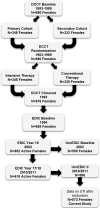Glycemic Control and Urinary Tract Infections in Women with Type 1 Diabetes: Results from the DCCT/EDIC
- PMID: 27131462
- PMCID: PMC5025347
- DOI: 10.1016/j.juro.2016.04.071
Glycemic Control and Urinary Tract Infections in Women with Type 1 Diabetes: Results from the DCCT/EDIC
Abstract
Purpose: We examined the relationship between glycemic control and urinary tract infections in women with type 1 diabetes mellitus.
Materials and methods: Women enrolled in the Epidemiology of Diabetes Interventions and Complications study, the observational followup of the Diabetes Control and Complications Trial, were surveyed to assess the rate of physician diagnosed urinary tract infections in the preceding 12 months. The relationship between glycated hemoglobin levels and number of urinary tract infections in the previous 12 months was assessed using a multivariable Poisson regression model.
Results: A total of 572 women were evaluated at year 17. Mean age was 50.7 ± 7.2 years, mean body mass index was 28.6 ± 5.9 kg/m(2), mean type 1 diabetes duration was 29.8 ± 5.0 years and mean glycated hemoglobin was 8.0% ± 0.9%. Of these women 86 (15.0%) reported at least 1 physician diagnosed urinary tract infection during the last 12 months. Higher glycated hemoglobin levels were significantly associated with number of urinary tract infections such that for every unit increase (1%) in recent glycated hemoglobin level, there was a 21% (p=0.02) increase in urinary tract infection frequency in the previous 12 months after adjusting for race, hysterectomy status, urinary incontinence, sexual activity in the last 12 months, peripheral and autonomic neuropathy, and nephropathy.
Conclusions: The frequency of urinary tract infections increases with poor glycemic control in women with type 1 diabetes. This relationship is independent of other well described predictors of urinary tract infections and suggests that factors directly related to glycemic control may influence the risk of lower urinary tract infections.
Keywords: diabetes mellitus; risk factors; urinary tract infections.
Copyright © 2016 American Urological Association Education and Research, Inc. Published by Elsevier Inc. All rights reserved.
Figures
Comment in
-
Editorial Comment.J Urol. 2016 Oct;196(4):1135. doi: 10.1016/j.juro.2016.04.110. Epub 2016 Jul 13. J Urol. 2016. PMID: 27421710 No abstract available.
Similar articles
-
Glycaemic control and risk of incident urinary incontinence in women with Type 1 diabetes: results from the Diabetes Control and Complications Trial and Epidemiology of Diabetes Interventions and Complications (DCCT/EDIC) study.Diabet Med. 2016 Nov;33(11):1528-1535. doi: 10.1111/dme.13126. Epub 2016 Apr 24. Diabet Med. 2016. PMID: 27028025 Free PMC article.
-
Severe hypoglycemia and coronary artery calcification during the diabetes control and complications trial/epidemiology of diabetes interventions and complications (DCCT/EDIC) study.Diabetes Res Clin Pract. 2015 Feb;107(2):280-9. doi: 10.1016/j.diabres.2014.10.007. Epub 2014 Oct 23. Diabetes Res Clin Pract. 2015. PMID: 25467622 Free PMC article.
-
Effects of Prior Intensive Insulin Therapy and Risk Factors on Patient-Reported Visual Function Outcomes in the Diabetes Control and Complications Trial/Epidemiology of Diabetes Interventions and Complications (DCCT/EDIC) Cohort.JAMA Ophthalmol. 2016 Feb;134(2):137-45. doi: 10.1001/jamaophthalmol.2015.4606. JAMA Ophthalmol. 2016. PMID: 26584339 Free PMC article. Clinical Trial.
-
Understanding Metabolic Memory: A Tale of Two Studies.Diabetes. 2020 Mar;69(3):291-299. doi: 10.2337/db19-0514. Diabetes. 2020. PMID: 32079705 Free PMC article. Review.
-
Insights from the diabetes control and complications trial/epidemiology of diabetes interventions and complications study on the use of intensive glycemic treatment to reduce the risk of complications of type 1 diabetes.Endocr Pract. 2006 Jan-Feb;12 Suppl 1:34-41. doi: 10.4158/EP.12.S1.34. Endocr Pract. 2006. PMID: 16627378 Review.
Cited by
-
Systematic Review of Literature Examining Bacterial Urinary Tract Infections in Diabetes.J Diabetes Res. 2022 May 17;2022:3588297. doi: 10.1155/2022/3588297. eCollection 2022. J Diabetes Res. 2022. PMID: 35620571 Free PMC article.
-
Asymptomatic Bacteriuria in Patients with Type 2 Diabetes Mellitus.Infect Dis Rep. 2023 Jan 5;15(1):43-54. doi: 10.3390/idr15010005. Infect Dis Rep. 2023. PMID: 36648859 Free PMC article.
-
Autonomic neuropathy and urologic complications in diabetes.Auton Neurosci. 2020 Dec;229:102736. doi: 10.1016/j.autneu.2020.102736. Epub 2020 Oct 16. Auton Neurosci. 2020. PMID: 33197694 Free PMC article. Review.
-
The Predictive Value of Glycated Hemoglobin and Albumin for the Clinical Course Following Hospitalization of Patients with Febrile Urinary Tract Infection.Infect Chemother. 2018 Sep;50(3):228-237. doi: 10.3947/ic.2018.50.3.228. Infect Chemother. 2018. PMID: 30270582 Free PMC article.
-
Glycemic control and diabetes complications among diabetes mellitus patients attending at University of Gondar Hospital, Northwest Ethiopia.Diabetes Metab Syndr Obes. 2018 Dec 21;12:75-83. doi: 10.2147/DMSO.S185614. eCollection 2019. Diabetes Metab Syndr Obes. 2018. PMID: 30613158 Free PMC article.
References
-
- Foxman B. Urinary tract infection syndromes: occurrence, recurrence, bacteriology, risk factors, and disease burden. Infect Dis Clin North Am. 2014;28:1. - PubMed
-
- Stapleton A. Urinary tract infections in patients with diabetes. Am J Med. 2002;113(Suppl 1A):80S. - PubMed
-
- Muller LM, Gorter KJ, Hak E, et al. Increased risk of common infections in patients with type 1 and type 2 diabetes mellitus. Clin Infect Dis. 2005;41:281. - PubMed
-
- Boyko EJ, Fihn SD, Scholes D, et al. Diabetes and the risk of acute urinary tract infection among postmenopausal women. Diabetes Care. 2002;25:1778. - PubMed
-
- Shah BR, Hux JE. Quantifying the risk of infectious diseases for people with diabetes. Diabetes Care. 2003;26:510. - PubMed
Publication types
MeSH terms
Substances
Grants and funding
LinkOut - more resources
Full Text Sources
Other Literature Sources
Medical



